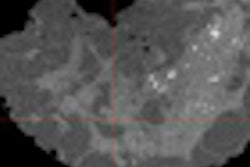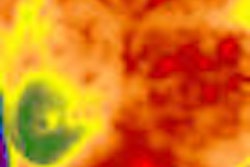Full-field digital mammography (FFDM) has been shown to find more cancers compared to film-screen breast imaging in large, multicenter trials conducted mostly at academic centers. But how does digital technology fare in a community setting?
Quite well, according to Dr. Fred Vernacchia, medical director of a small imaging center in San Luis Obispo, CA. Vernacchia found that FFDM does indeed catch more cancers in a community setting -- although at the price of more recalls -- in a paper published in the August issue of the American Journal of Roentgenology (2009, Vol. 193:2, pp. 582-585).
Vernacchia and a colleague evaluated the effects on recall rate and cancer detection when Vernacchia's facility, the San Luis Diagnostic Center, converted from film-screen to digital mammography.
"Our unique, small clinic environment allowed us to perform a statistical analysis of not just our facility as a whole, but also to analyze the analog-to-digital conversion, controlling for each radiologist," the authors wrote.
They performed four audits during a four-year period that included the year before conversion to digital mammography, as well as the first, second, and third years after conversion. Overall, 26,386 mammograms were evaluated in the study:
- 4,838 film-screen mammograms were acquired on an analog unit during audit 1.
- 6,875 screenings were performed using a digital system during audit 2.
- 7,379 screenings were performed using a digital system during audit 3.
- 7,294 screenings were performed using a digital system during audit 4.
Two radiologists interpreted 92% of the exams read in audit 1; in audits 2, 3, and 4, these two radiologists and a third one interpreted all exams.
The audit data showed that after an initial increase in detection rate following the adoption of digital mammography, the rate returned to a level that was higher than it had been with film-screen.
Detection and recall rates, FFDM versus film-screen mammography
|
Detection rates increased from 4.1 per 1,000 during audit 1 (film-screen year) to 7.9 per 1,000 the year after digital mammography was introduced (audit 2). Audit 3 showed no statistically significant difference in cancer detection rates from those in audit 1, decreasing to 5.1 per 1,000.
But audit 4's cancer detection rate was 6.9 per 1,000, which Vernacchia suggested could also be attributed to a high percentage of women with dense breasts, 40- to 50-year-old women, or premenopausal women in his center's population.
"The most surprising thing to me from the beginning was that there not only was a fairly dramatic increase in the cancer detection rate from audit 1 to audit 2, but also that it held up over three years later," Vernacchia told AuntMinnie.com.
"I believe one of the reasons is that with our system, we can set up hanging protocols that allow us to rapidly cycle through different ways to view the current exam and priors, including the ability to invert black and white," he said. "It's allowed me and my colleagues to pick up subtle, developing asymmetries that we might not have found with analog images."
Recall rates also increased the year after digital mammography was put into use, climbing from 5.9% in audit 1 to 10.2% in audit 2. Audit 3 showed a recall rate of 7.5%, and audit 4 showed a rate of 9%. The bump in callbacks in the first year of digital mammography use is consistent with the experience of others who convert to the technology, the authors wrote.
And although the size of cancers found with film-screen and digital mammography was not included in the study data, the results showed that they found more, smaller cancers with digital than with analog, Vernacchia told AuntMinnie.com.
"Of the cancers we detected the first year after installing digital, 70.4% were 15 mm or smaller in diameter. The national average is 55%," he said. "By the third year of using digital, 86% of the cancers we found were 15 mm or smaller."
The study highlights the fact that it's becoming increasingly difficult to justify not using digital technology, Vernacchia said.
"Given the added cancer detection rate, [adopting digital mammography] becomes worth doing," he said. "If you look at your numbers and ask yourself whether you can get a higher number of patients through per unit time with digital -- given that the bulk of a center's expenses is the cost of technology -- you can justify the expense. And besides, more and more women are demanding digital."
Vernacchia hopes this study will encourage other small centers to perform a similar analysis.
"We hope that our results will stimulate other small community-based imaging centers and practices to perform and publish similar audits so that more data on the experience of conversion to digital mammography can be shared with the radiology community," the study concluded.
By Kate Madden Yee
AuntMinnie.com staff writer
July 23, 2009
Related Reading
Conversion to FFDM requires careful management of analog priors, July 17, 2009
EMR-driven reminders boost mammo compliance, July 15, 2009
Mammography procedure volume drops 16% since 2000, March 17, 2009
AJR studies show decline in mammo use, workforce shortages, February 3, 2009
Trends in mammography utilization: Cause for alarm in Medicare population, May 27, 2008
Copyright © 2009 AuntMinnie.com




















